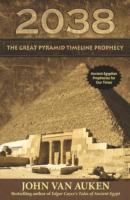2038 The Great Pyramid Timeline Prophecy. John Van Auken
Чтение книги онлайн.

Читать онлайн книгу 2038 The Great Pyramid Timeline Prophecy - John Van Auken страница 10
Название: 2038 The Great Pyramid Timeline Prophecy
Автор: John Van Auken
Издательство: Ingram
Жанр: Эзотерика
isbn: 9780876047521
isbn:
Let’s not include the people who built the Nabta Playa “stonehenge,” which would extend the beginning of this culture back closer to 9560 BC, because they were not well known by the Egyptians who subsequently wrote about them. With all of this in mind, we are looking at the views of a people who lived along the Nile River from roughly 4000 BC (predynastic) to 525 BC (the Persian invasion). These are the ancient Egyptians in the context of this information.
Ancient Egyptian Perspectives
In the Egyptian Book of the Dead, the existence of the deceased or initiate began long before its incarnation into this world. But the passage of the entity from this world to the next is from its human incarnation, through the transition of physical death, on through many transcending experiences and tests, until it reaches its ultimate potential: a fully conscious and eternal Star-god in the infinite heavens, living among the other light beings of creation. In the Egyptian Book of the Dead the deceased or initiate asserts that he or she was originally conceived in the primordial “sea” of infinity by the self-created god-of-all-gods Atum (also written Tem). The following creation myth is found in the pyramid text of the Egyptian Book of the Dead on the walls of Pepi I’s pyramid:
The story begins with a creative essence appearing out of the infinite, dark nothingness—willing itself into being. This essence evolved into a creator called Atum (also known as Atem and Tem, in Wallis Budge’s translation of the Egyptian Book of the Dead he uses Tem). This name means the “Complete One.” Within the Complete One was his shadow, which was the infinite womb of mother Iusaaset (pronounced e-oo-sa–ah-set; meaning “mother of the first gods” but also “grandmother of the subsequent gods”). The two of them—the self-created Atum and the unseen Iusaaset—conceived breath and moisture. Sadly, these two offspring became lost in the infinite chaos of dark nothingness; therefore Atum conceived of the conceiver of Light (Ra). The Light was born inside the dark chaos. Atum sent the Eye of Light that penetrates the darkness to find the lost primordial children. The Eye of Light was Ra. When Ra rose from the hidden depths of the primordial sea, he immediately gave life to Ma’at, “Truth.” Ancient Egyptians believed that the creation we know could not have come into existence until Truth (Ma’at) first established order, balance, and harmony. The Egyptians believed that if Truth (Ma’at) had not been conceived, then chaos would have reigned and the primordial sea would have reclaimed the manifested universe into her unseen depths. With order established, and upon finding the lost children, Atum, who was now united with Ra, was now called Atum Ra (see illustration 12), he then named Breath life, and Moisture order. Then, Atum Ra bound Life and Order together and with these two now united, he made air (the Egyptian god Shu) and mist (Tefnut). Then, by kissing his daughter Mist, Atum Ra created the first mound (firmament) in the primordial sea, which was the Ben-ben Mound. Like the Mayan legend of the celestial turtle rising from out of the infinite primordial sea, the Ben-ben Mound rose from out of the vast expanse of the motionless sea of the infinite depths. Then Atum Ra rested on the mound, while lifeair (Shu) and order-mist (Tefnut) mated to create earth (the god Geb) and sky (the goddess Nut, pronounced noot, rhymes with toot). Earth and Sky then conceived five more godlings: Osiris, god of fertility, resurrection, and judge of the heart of every soul; Isis, goddess of magic, motherhood, and “Mother of the Universe”; Set, god of chaos, confusion, storms, wind, the desert, and foreign lands; Nephthys, “Mistress of the House,” “Friend of the Dead,” and goddess of divine help and protection; and Horus the Elder, god of light, whose left eye was the sun and right eye the moon. (See illustration 13.)
In this creation story we see the original chaos of “dark nothingness” and then the subsequent personification of chaos in the god “Set.” In the Egyptian Book of the Dead, there is “the day of the combat of the Two Fighters”; these were none other than Set and Horus with Set being the chaos and Horus being the light. During these times there was an upside-downness, evil reigned over goodness, symbolized by Set’s victory over Osiris, in which goodness was scattered to the four winds by Set’s dismembering of Osiris’ body; thus no one could see the full nature of the goodness and stability that perfect Osiris represented.
In this story we also learn how the Egyptians believed that everything had a balancing counterpart: the infinite darkness had the Eye of Light, chaos had truth
Конец ознакомительного фрагмента.
Текст предоставлен ООО «ЛитРес».
Прочитайте эту книгу целиком, купив полную легальную версию на ЛитРес.
Безопасно оплатить книгу можно банковской картой Visa, MasterCard, Maestro, со счета мобильного телефона, с платежного терминала, в салоне МТС или Связной, через PayPal, WebMoney, Яндекс.Деньги, QIWI Кошелек, бонусными картами или другим удобным Вам способом.